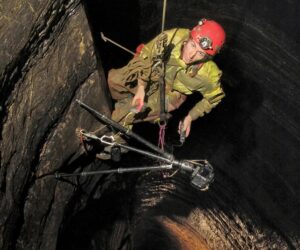Home Story Last Exit From The Secret Sea
Last Exit From The Secret Sea
Feature type Story
Read time 12 min read
Published May 20, 2021
Author Robbie Shone
Photographer Robbie Shone
In a remote part of the Arabika Massif in Georgia’s West Caucusus, over 2000 meters below the Earth’s surface, a team of top international cavers are suddenly confronted with a life-or-death situation. With no more than a few minutes to decide the right course of action, in the deepest part of the world’s deepest cave, they must choose the only option that guarantees their survival. Robbie Shone, who was part of the team, recalls of one of the most gripping escape stories of contemporary adventure.
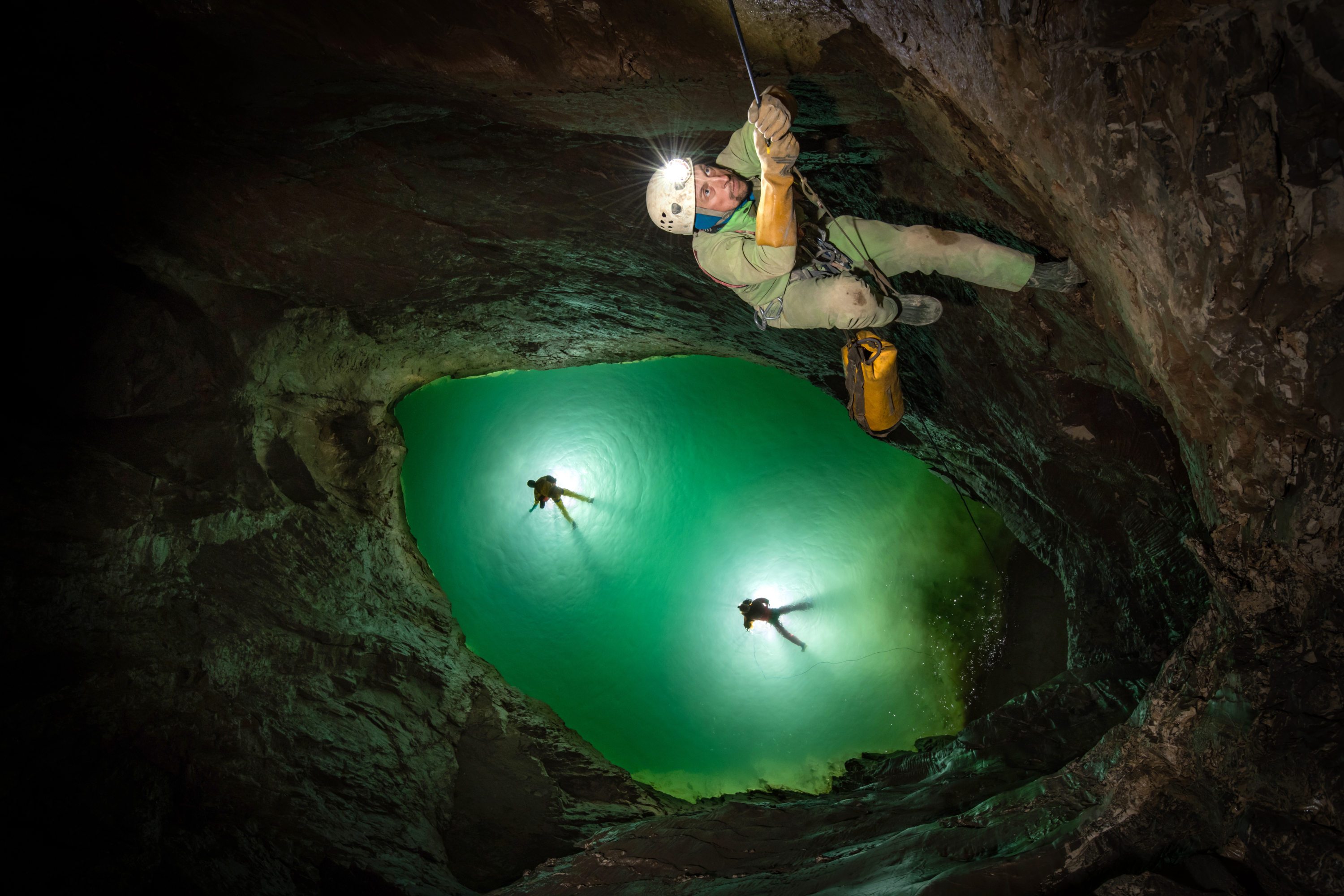
The lowest point in the cave. The siphon. Up until this expedition, this siphon is undived and nobody knows what lies beneath. This is the deepest point in the deepest cave in the world! At -2212m underground. Leader Pavel Demidov climbs up the rope above two swimmers swimming in the sump pool 12m below. A strong current coming up from the left hand side suggests that there might be a flooded passage below the surface, but up to now, who knows? During the flood pulse that cave down through the cave a week after this photograph was taken, all of this completley filled up with water, right up to the roof.
The Veryovkina cave in Georgia is the world’s deepest cave system so far explored. It is a physically testing cave, with many torturous sections, some only just wide enough to squeeze one’s body through. Due to the enormous depth of the cave, it is necessary to use multiple underground camps to reach the cave’s deepest point at -2,212 meters. The camps are at -600m, -1,350m, and the final one lies at –2,100m. The process of getting to the bottom of this remarkable cave is similar to a camp-to-camp ascent of an 8,000 metre peak, except you’re going down instead of up.
There’s an average travel time of eight hours between each of the camps for a caver carrying two or three bags weighing 20-30kg each. After taking four days to reach the bottom of Veryovkina, we spent seven of our fourteen days in the cave based at the lowest camp, which was the ideal location for exploring the farthest reaches of the system. In general, everything went well as we made day trips away from the camp to explore and photograph the lower passages. I was able to photograph the outlandish terminal sump [image above]: this is the first photo ever taken of the deepest point in the deepest cave on Earth.
Everything changed on day seven of the camp. From an expedition going smoothly, we were suddenly thrust into survival mode. We received a radio call from two cavers higher up in the system to say that there was a flood pulse coming through. It was estimated that the water would reach us in about 30 minutes. We continued with our breakfast, unaware of the seriousness of what was coming our way. Then, without warning, the water hit us. I will never forget that sound. The cave was filled with a deafening roar, as if a freight train was about to thunder through our camp. And it got louder and louder. Everyone stood open-mouthed staring upwards, wondering what was going to appear from the black hole in the cave ceiling above
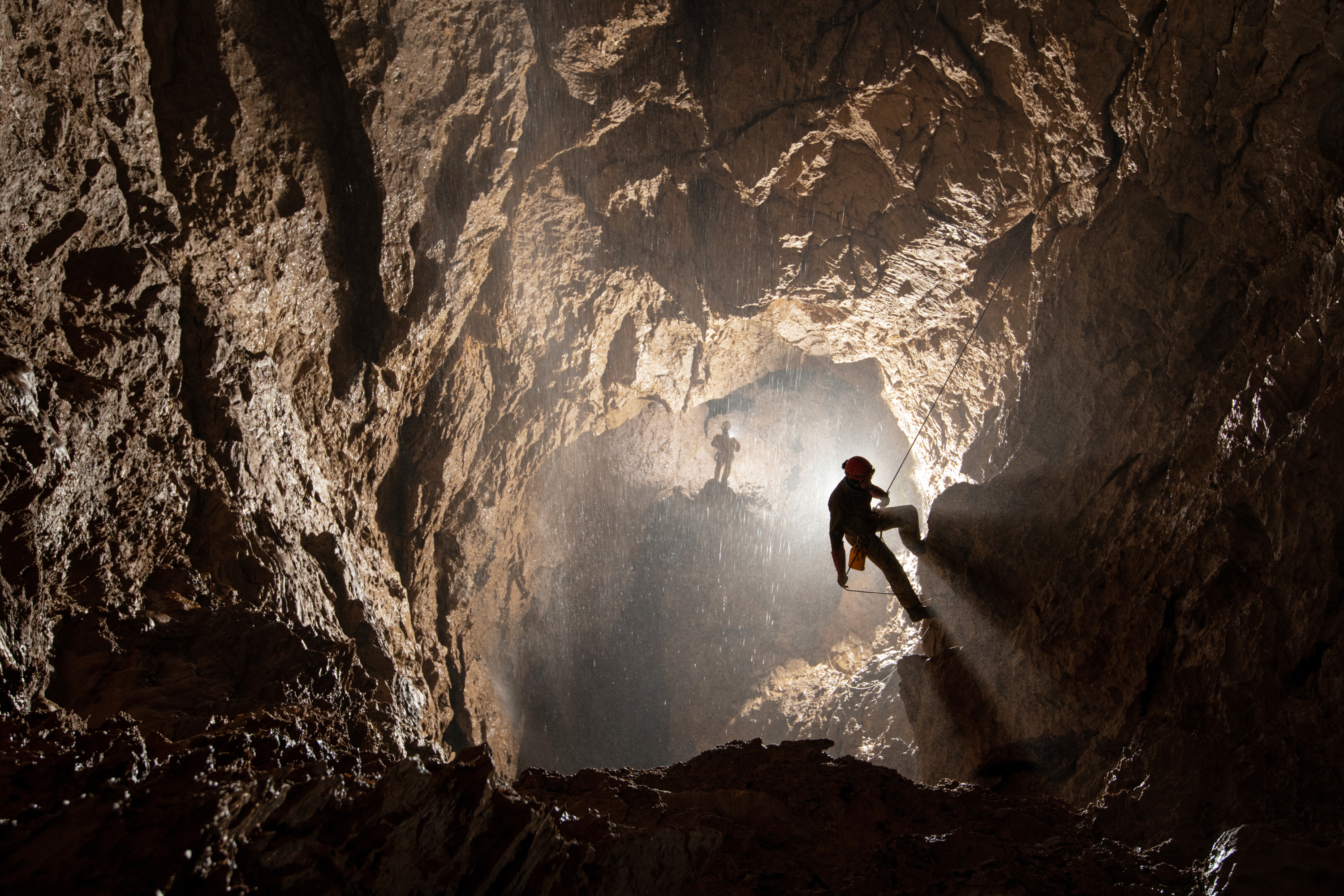
Two of the Russian explorers begin their journey into the lowest levels of the cave. This is a view from close to the lowest camp at -1900m below ground and where the rope comes in from the surface, 1900m above. This is also the shaft from where all the flood water plummeted a week after this photograph was taken. Here, it is in pretty much normal conditions. When the flood pulse came, all this space was wall to wall white water. It was terrifying and extremely loud.
It was impossible to tell how fast the water was rising; a hole in the cave floor suddenly filled and surged
Then it came. About two minutes after first hearing the train, the most enormous torrent of white water appeared 15m (45ft) above our heads and plummeted down to camp. At first it continued past us, heading further down into the cave. We decided not to continue with our original plan for the day but to wait around camp and see how it would develop. I took the opportunity to photograph camp. After a couple of hours, Petr, one of the Russian cavers could hear gurgling coming from a three metre deep hole. The leader, Pavel, and one other left at this point to go and check how the water levels were changing deeper in the system. Then all hell broke loose.
The water rose so fast it was impossible to tell how quickly it was rising. Petr checked the hole once again, and as he turned around his white face said it all. The three metre deep hole was now full of surging, rising water.
We knew we had to act fast: the message was passed around that we had to evacuate our camp. Everyone started running around, gathering equipment and clothing. In camp we only had base layers on. We had to get kitted up for serious caving.
We put dry suits on (which would save our lives later on in the 5ºC water), harnesses and climbing gear. Because I’d been photographing only moments earlier, my camera gear was spread all over the floor. I grabbed the cards from the camera, put them in a ziplock bag and into my chest pocket and left the rest. Had I taken the equipment, carrying a bag would have slowed me down and therefore the people behind me. It would have endangered our lives even more.
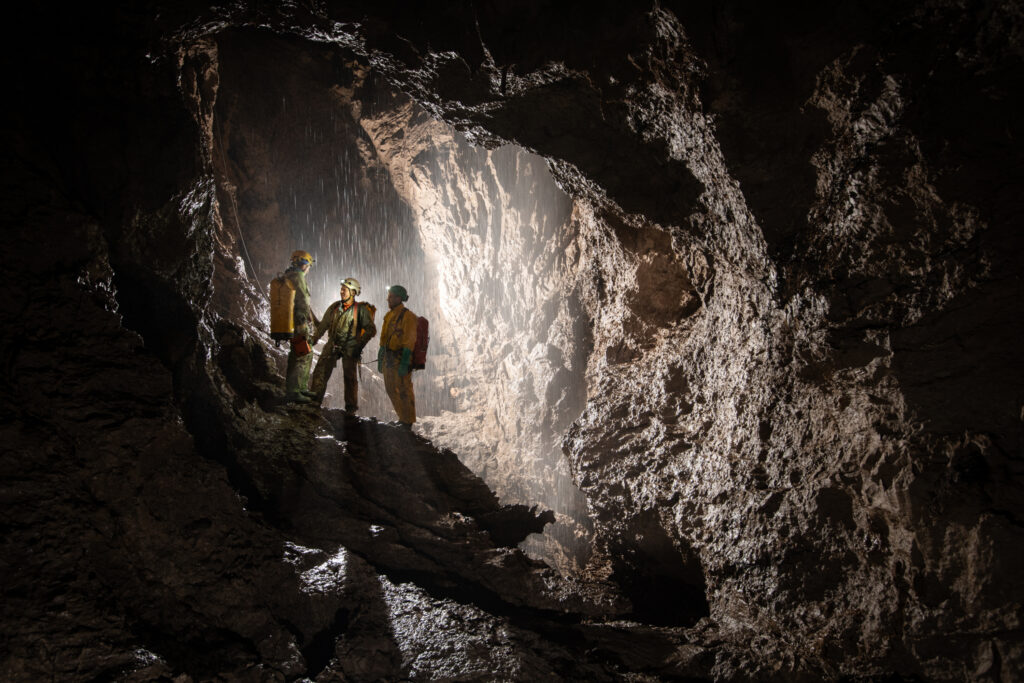
Three members of the team stop for a discussion before heading back to their underground camp (the lowest camp at 1900m underground). A trickle of water falls down behind the team. This is the location where the flood pulse plummeted down a week later, totally filling up all of the passage.
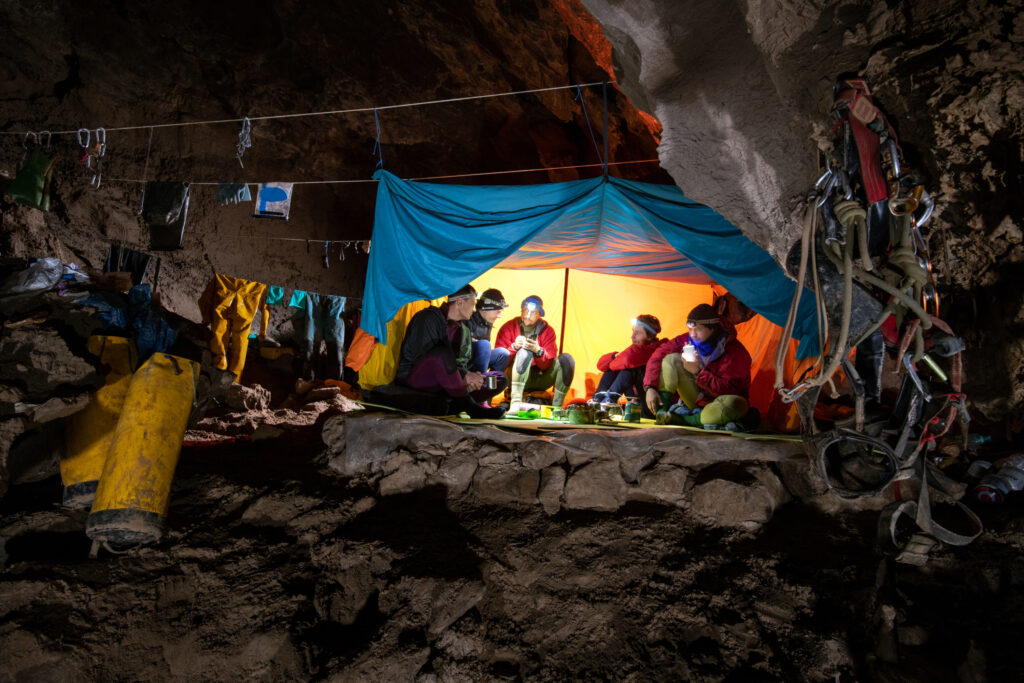
At -1900m underground, this is a picture of the teams lowest camp inside the cave. The Russian explorers have devised a great system to stay warm and dry. Inside that tent, five team members sit in their fleece undersuits and prepare a meal and/or a tea to drink. The heat from the gas stoves warm up the air inside the tent and dry out any wet clothes. Meanwhile the outer suits remain wet, whilst hanging up on clothes lines outside the tent. During the flood pulse that cave down through the cave a week after this photograph was taken, all of this completley filled up with water, right up to the roof.
‘We’re leaving right now,’ I said as soon as my assistant, Jeff, was ready. At this point every single hole around camp was rising and bubbling. First, we had to negotiate a traverse, which previously had been above a fifteen metre drop. This was now a lake and the traverse was only a metre above the water. Then we had to ascend 50 metres of fixed rope pitches, which were all now raging waterfalls.
I don’t know whether I was more scared about the rising water behind, or the torrent of water coming down on our heads. The only way to breathe while climbing up through the waterfalls was to keep our heads down, put our chins on our chest, and create a small air space underneath the front of the helmet. I was terrified. Panicked, I climbed the ropes as fast as possible, moving so quickly I lost sight of Jeff.
I honestly thought, for a few long minutes, that Jeff and everyone else behind me in the cave was dead. Finally, I heard a very angry voice on the ropes below me. It was Jeff yelling at me to slow down; it was a relief to see and hear him. We re-grouped and continued onwards to a point where we could wait safely out of the raging water and have a think about what to do next.
Whilst there, the first of the other cavers began to appear from the darkness below. We asked him if he’d seen the others: he said no. We didn’t say it, but in our hearts we assumed they were all dead.
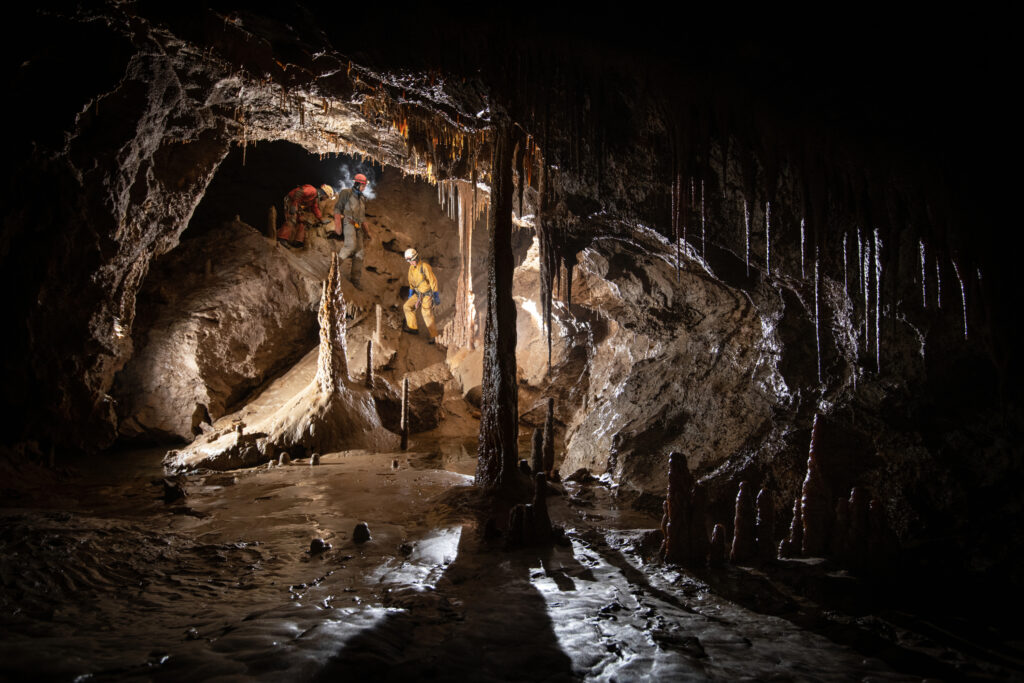
A small but pretty grotto in the entrance section of the lowest levels of the cave system that lies just above the water table. Pictured here, (my assistant) Jeff follows Roman and Natasha down a calcite ramp and through the grotto made of flowstone. It is very rare and unusual to see so much flowstone and stal this deep in a cave, espically an active cave that fills to the roof in flood conditions. During the flood pulse that cave down through the cave a week after this photograph was taken, all of this completley filled up with water, right up to the roof.
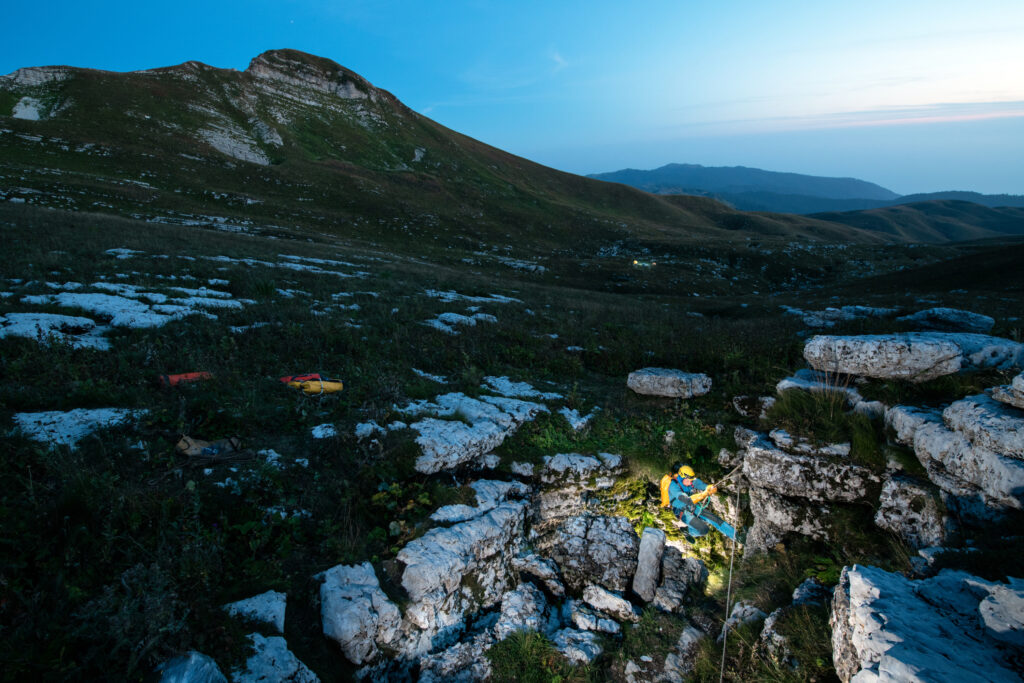
Leader of the expedition, Pavel Demidov is seen emerging from the cave entrance. This is a photograph of the entrance to Veryovkina – the deepest cave in the world (-2212m). Cvaing bags lie on the grass ready to go into the cave. In the background the lights from the teams base camp can be seen a little way down the mounatinside. View looking south west. Arabica massif lies immediately behind this view.
The three of us continued to the next camp at -1,900m and waited there. A few minutes later, the other cavers bringing up the back of the group started to appear, much to our general relief.
These guys are all so strong and immensely capable: they all carried sleeping bags and stoves, as they knew there was a food store at the next camp. All eight of us regrouped. Everyone had survived, though we learnt that as the others had left camp, they were swimming above the tents. The traverse line that was a metre above the water when we left was several metres underwater when they left. They had to claw their way along the wall. Pavel, the leader, was spat out into an eddy and he had to swim hard to regain the rock. Petr injured his knee quite badly, but it was remarkable that this was the most serious incident from the escape as a whole.
At Camp -1,900m we felt relatively safe, but the floodwater was still flowing strongly through the cave. We couldn’t continue upwards because the next waterfall was impassable. We waited for 16 hours.
Jeff and I were still in shock, and concerned as to whether the water would rise even more: we were now stuck at this temporary camp between the rising flood waters below and an impassable waterfall above, surrounded by the thundering subterranean river. Meanwhile, the Russian cavers jovially arrived at the temporary camp, which raised their spirits instantly. Soon they were all laughing amongst themselves. Eventually after several hours and some coaxing, we did the same. Whilst four team members slept, or tried to, the other four kept watch of further rising water levels, and this was done in shifts.
After many hours, the water level died down as quickly as it had risen as the flood pulse was receeding. Jeff and myself escorted Petr, with his injured knee, to the next camp. The others, amazingly, went back down to the lower level to try and salvage what they could from camp. They found my camera and tripod, which they used for fishing out what else they could find. One of my waterproof containers was located, deformed and wedged in the roof. It remains there to this day along with the majority of my other camera equipment.
It took four days to return to the surface from the bottom of the Veryovkina cave. I had planned to photograph the upper part of the cave on exiting, but with everything lost or flooded, this was no longer possible. For the Russians, they learnt from this extreme experience of how the whole cave system reacts quickly under certain weather conditions. Plans are already underway to improve surface monitoring without the need to have someone physically sat there for two or more weeks at a time giving updates via radio.
A Brief History of Veryovkina Cave
1968 The cave is discovered by cavers from Krasnoyarsk, Russia. They reach a depth of -115m and mark the cave on the map as S-115.
1982 The cave is explored a second time by a group of Moscow cavers. It is marked as P1-7.
1983-86 Cavers from the same Moscow team continue to explore the cave and reach a depth of -440m. The cave is renamed after Alexander Veryovkin who died in 1983 exploring a siphon in a cave in the Su-Akan.
2000-2015 Ten expeditions from the Perovo caving team explore the cave further, not making much progress until 2015 when they find a new shaft (named ‘Babatunda’) that opens the way for deeper discovery of the cave system.
2017 The Perovo team make a major breakthrough in the cave, setting a world caving depth record of -2,204m and exploring over 13.5km of cave shafts.
2018 The cave is surveyed by the Perovo team all the way down to the terminal siphon at -2,212m
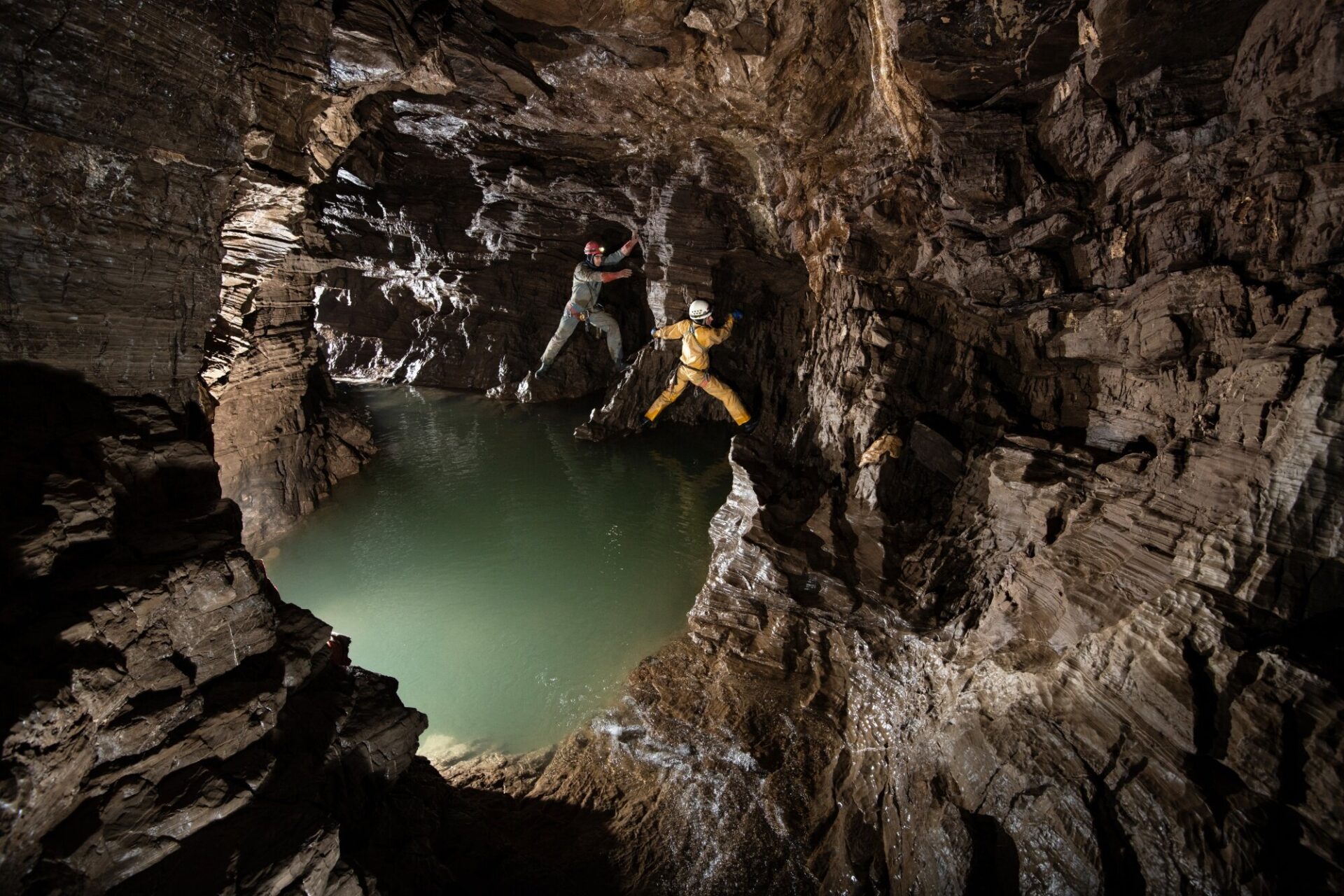
Natasha Sizikova and Roman Zverev of the Perovo Speleo Caving Team on a traverse around a deep pool of water in one side passage off the main route through the lowest levels of Veryovnika. During the flood pulse that raged into these chambers during the expedition this gallery completely filled up with water, and was totally submerged.
The premature exit from the cave lost around a day’s worth of time, in the deepest part of the system. Prior to this a number of new passages had been explored and mapped, several cave invertebrates taken for analysis, and a number of climbs completed to check potential high-level passages, and not forgetting the photography and some filming. Despite – and because of – our lucky escape, it had been a successful expedition.
For myself, it was a pleasure to work with the Perovo-Speleo caving team and a very emotional trip at that. For almost twenty years I have been involved in cave exploration and photography. This trip for the first time brought home the fact that deep cave exploration is not just for the average caver. To be capable of such an undertaking, years of caving experience are needed. One must have an extremely high level of physical endurance to ensure a sufficient margin of safety. When something goes wrong in a very deep cave like Veryovkina, you need to act fast. It’s crucial that you haven’t used all your reserves up just getting to the bottom of the cave. In mountaineering, the most dangerous part of the climb can be the descent, and in a big cave the most challenging part can be getting out again. One also needs a very high level of technical expertise to negotiate the ropes. Had just one person become stuck on a rope during the flood, then this would have created a bottleneck, almost certainly killing everyone who remained behind.
These qualities of great endurance, good decision making and teamwork form the basis of the Perovo-Speleo Caving Team. It’s no surprise, given their expertise in expedition-style caving, that they are pushing the limits in the deepest caves in the world. For me, these people are in the leagues of the great explorers not just of the modern era, but of all time.
Don’t miss a single adventure
Sign up to our free newsletter and get a weekly BASE hit to your inbox
You might also like
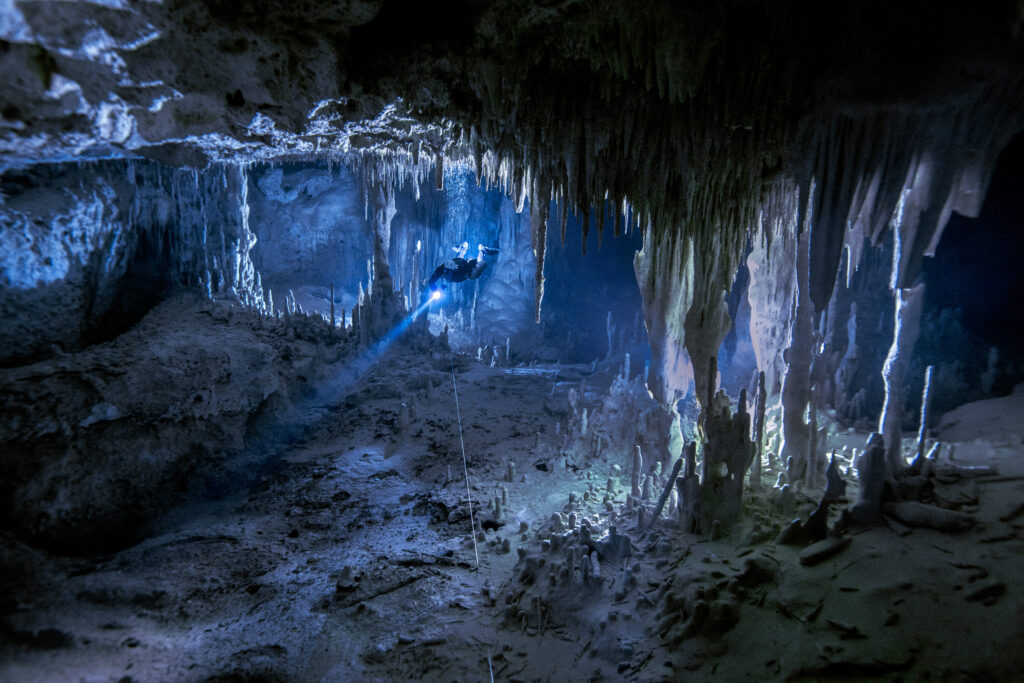
Story • Ben Horton • Jun 28, 2022
A Deeper Understanding
Lessons in facing the unknown in Mexico's underwater cave systems
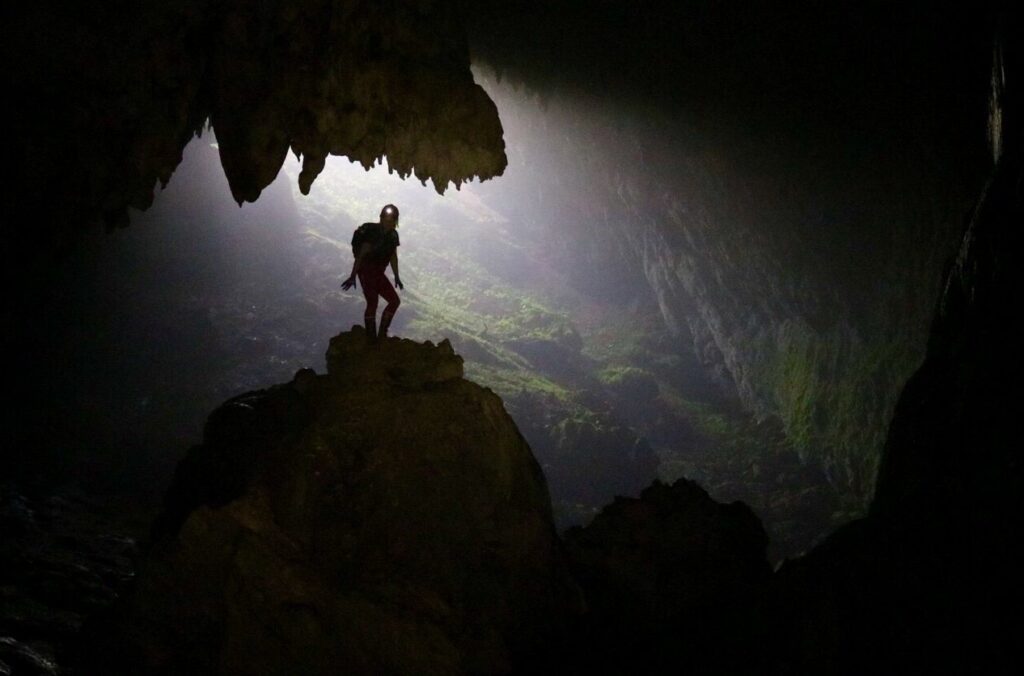
Story • David Weimer • Nov 02, 2021
The Lost Kingdom
Subterranean expeditions into the Parque Nacional de las Cavernas del Río Camuy
